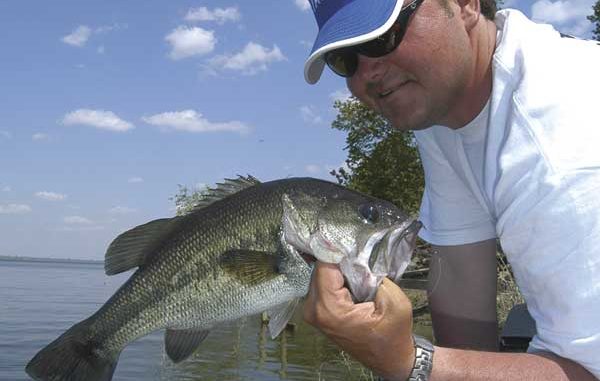
The first split gets all the attention, but the second and third splits of the dove season are when the fireworks really fly.
Lake Providence, an old Mississippi River oxbow lake in extreme northeastern Louisiana, has plenty of good bass in it. In October, the shad really become active, and start moving up on the banks. The bass will chase and eat shad to fatten-up for winter.
The day dawns
First thing in the morning, I’ll fish the really flat banks because normally, at this time of year, the shad will be running those flat banks. To catch these bass, I’ll fish a Strike King 3/8- or 1/2-ounce white buzz bait with either white or silver blades, depending on the amount of cloud cover. I won’t really be swimming this buzz bait around any type of cover, but will be casting it up on those flats.
At this time of year, the lake should have low water levels. Most of the cover the bass are accustomed to holding on will be on the bank. So the bass will be roaming those flats, looking for shad to eat.
You may find an isolated cypress tree or boat dock on these flats. But I’m not betting on any type of cover to help me find bass. I’ll mostly will be concentrating on locating baitfish, where bass will concentrate.
Early in the morning, you can see shad flipping on the surface in about 1 to 3 feet of water. You may spot bass busting those schools of shad. However, when lakes are low, the bass won’t be breaking the surface. You’ll be blind-casting to open water with this technique.
I’ll be fishing 20-pound-test Gamma fluorocarbon line tied to my buzz bait with a 7-foot, medium-heavy action Quantum Tour Edition PT rod and a Quantum Tour Edition PT Burner 7.0:1 baitcasting reel. I like a 7.0:1 reel because I don’t have to reel as fast to take up line and move the bait. I can engage the reel as soon as the buzz bait hits the water, and that bait will start coming back to me on top of the water.
I’ll fish this way until 7 or 8 a.m., depending on the weather. If the weather’s cooler than normal, I may fish the buzz bait until 10 a.m.
Morning bite ends
If the lake has some stain in it and a little wind, I’ll fish a Strike King Premier Elite spinnerbait. I’ll have a 4- and 4 1/2-inch willowleaf blade on my spinnerbait in a shad pattern — either green shad, white or white/chartreuse. I’ll leave the flats and target the structure and cover I believe the bass will move to after they stop feeding on the flats. I’ll slow-roll the spinnerbait around isolated cypress trees, lay-down logs and boat docks. This lake has many boat docks, and bass will suspend under them.
Afternoon
Later in the day, the bass will move back toward the flats to feed again on the shad. I prefer to fish lipless crankbaits like the Strike King Red Eye Shad or the Diamond Shad because they look and swim like shad. So I’ll hold my boat in 6 or 7 feet of water, and cast right to the bank.
If the fish are deep, and I don’t have wind to cast into, I’ll probably fish the Diamond Shad because it has a tighter wiggle than the Red Eye Shad does. The Red Eye Shad really works for me in more-shallow water than the Diamond Shad does because I can keep the Red Eye Shad swimming much more shallow and easier than I can the Diamond Shad. The bait pulls hard; therefore, it stays closer to the surface easier than the Diamond Shad does.
The colors I like will be chrome/blue, chrome/black and on a cloudy day, gold/black.
I’ll be fishing these lipless crankbaits on 20-pound-test fluorocarbon line. Many anglers use fluorocarbon because it’s invisible underwater. But I’ve also found that fluorocarbon line is better when you’re making long casts with a lipless crankbait because it has less stretch than monofilament line does, and it seems stronger.
Most people use monofilament line when they’re fishing lipless crankbaits because the stretch in the line allows the bass to get the lures deeper in their mouths than if they’re using braided line with no stretch.
However, I prefer to use a softer, more-forgiving rod, and use fluorocarbon line, which stretches less than monofilament. Then if the bass takes that lipless crankbait out at the very end of my cast, I have a greater chance to hook the fish with the fluorocarbon line, even with less stretch, and get the bass to come into the boat without jumping.
Late afternoon
In the late afternoon, I like to fish crankbaits — either a Strike King Series 4 or a Series 1 in green/chartreuse, blue/chartreuse or Tennessee shad.
To fish crankbaits successfully at this time of year, notice the size of the shad the bass are eating. If the shad are small, then I’ll fish a Series 1 crankbait. If the shad are bigger, then I fish a lure like the Series 4 crankbait. Oftentimes, the shad may be a little bigger than you expect, and you may need that bigger crankbait to more-closely resemble the size of baitfish the bass are eating.
This lake is really fertile, so the shad will generally have a green tint to them.
At Lake Providence at this time of year, you’ll generally catch numbers of 2- to 4-pound bass, and occasionally a bigger fish. However, from February to April, you have a really good chance of catching a bass 8 pounds or more in this lake.
One of the reasons I picked Lake Providence this month is because the water temperature here is cooler than it is in other oxbow lakes. If we have cool weather in October, you may want to consider fishing Lake Concordia or Lake Bruin near Tallulah.


